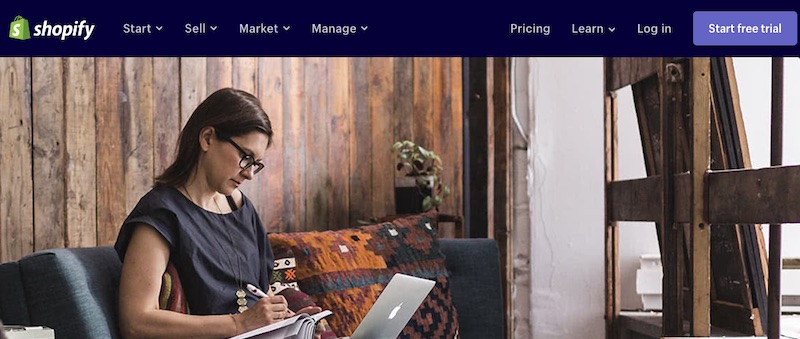
Shopify’s revenue for 2018 was $1.1 billion, up 59 percent over 2017. At its current stock price, Shopify’s market valuation is roughly $41 billion.
Operating in the shadow of online marketplaces and located in Ottawa, Canada, Shopify does not get as much attention as it should. A $41 billion market-cap business — NYSE: SHOP — Shopify is the choice of approximately 820,000 merchants in 175 countries, growing from 600,000 in 2017.
Shopify provides a multichannel commerce platform that allows merchants to set up their stores and display, manage, and sell their product across multiple sales channels. The company uses a SaaS system with software that provides a single integrated back-end infrastructure.
Using Shopify, merchants can sell online in several ways:
- On their own website.
- With a buy button on a blog or other website.
- In person at retail locations.
- On social media websites.
- And through online marketplaces such as Amazon, eBay, and Etsy.
In all cases Shopify provides back-office infrastructure. Shopify executives believe that merchants prefer to have a direct relationship with their customers and Shopify’s solutions allow them to incorporate that into their sales.
Business Model
Shopify has two revenue streams: (i) a recurring subscription component called Subscription Solutions and (ii) Merchant Solutions that enhance the subscription with payment services (Shopify Payments), shipping (Shopify Shipping), and working capital (Shopify Capital). More than two-thirds of Shopify’s merchants have enabled Shopify Payments, which eliminates the need for a third-party payment gateway.
Merchant Solutions now generate more revenue than Subscription Solutions.
Besides the actual subscriptions, Shopify generates associated revenue from the sale of custom themes and apps and the registration of domain names.
Shopify believes a major reason for its success is that it offers different plans to accommodate its clients. As merchants upgrade to the higher-priced options, they receive more powerful tools.
Pricing
Most merchants are on subscription plans that cost less than $50 per month, according to Shopify’s annual report. “Basic” Shopify costs $29 a month. Regular Shopify costs $79 a month and includes customer data reports. “Advanced” Shopify for larger businesses costs $299 a month and includes a sophisticated report builder and third-party shipping tools.
Shopify Plus, which serves about 5,300 merchants, provides an enterprise-level platform for high volume merchants. Pricing is customized. Nestlé, Rebecca Minkoff, and Leesa are Shopify Plus customers.
While most merchants subscribe to the Basic and Shopify plans, the majority of the company’s gross merchandise volume comes from merchants subscribing to the Advanced and Shopify Plus plans. Merchant retention rates are also higher among merchants on those higher-priced offerings, according to the company.
U.S. merchants comprise 55 percent of subscribers, followed by the United Kingdom at 8 percent, and Canada and Australia at 7 percent each.
Fourth-quarter Highlights
- Total revenue in the fourth quarter was $343.9 million, a 54 percent increase from the fourth quarter in 2017.
- Subscription Solutions revenue grew 42 percent from 2017 to $133.6 million.
- Growth was driven primarily by an increase in the number of merchants joining the Shopify platform.
- Merchant Solutions revenue grew 63 percent to $210.3 million, attributable primarily to the growth of gross merchandise volume and greater adoption of Shopify Capital and Shopify Shipping offerings.
- GMV for the fourth quarter was $14.0 billion, an increase of $4.9 billion, or 54 percent over the fourth quarter of 2017.
- Shopify Payments processed $5.8 billion in sales, a 65 percent increase year over year, and accounted for about 41 percent of the company’s GMV.
- Shopify Capital issued $71.8 million in merchant cash advances and loans in the fourth quarter of 2018, an increase of 81 percent over the $39.7 million issued in the 2017 fourth quarter.
Full-year Highlights
- Total revenue for the full year 2018 was $1.1 billion, up 59 percent over 2017. Subscription Solutions revenue grew 50 percent to $465.0 million while Merchant Solutions grew 67 percent to $608.2 million.
- Gross merchandise volume for 2018 was $41.1 billion, an increase of 56 percent over 2017.
- The net loss for 2018 was $64.6 million compared with $40.0 million for 2017. This is attributable to increased expenses for service offerings.
- The number of merchants on the Shopify platform achieving over $1 million in gross merchandise volume grew by 58 percent in 2018.
- Merchants selling on the Shopify platform for 12 months or more increased their gross merchandise volume year-over-year at an average monthly rate of 24 percent.
- In the fourth quarter, Shopify merchants added nearly 40 million products to their shops.
- Shopify opened a brick-and-mortar location in Los Angeles. It showcases Shopify’s products and services and serves as a hub for merchants who seek in-person support and guidance.
2019 Expectations
For the full 2019 year, Shopify expects revenue of $1.5 billion. Recreational marijuana sales became legal in Canada in October 2018, and several Canadian provinces have chosen Shopify for their ecommerce websites. The company has also signed marijuana growers as customers, and these sales are expected to contribute substantially to Shopify earnings.




